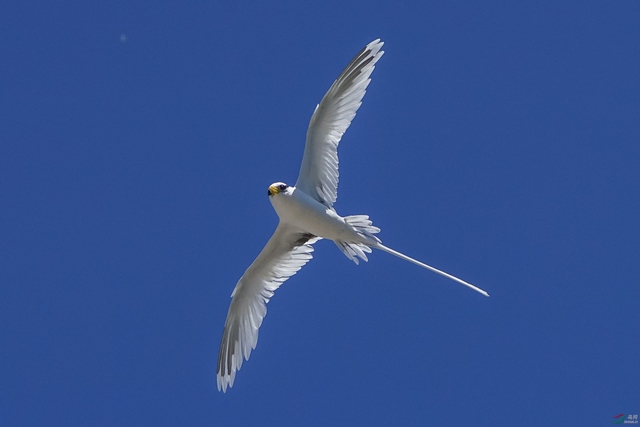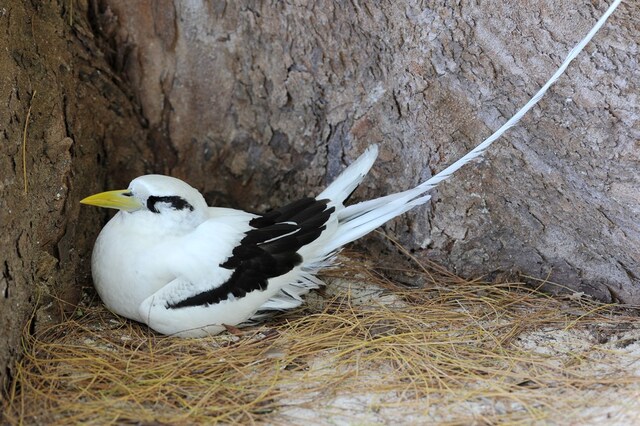Phaethon lepturus
IUCN
LCBasic Information
Scientific classification
- name:Phaethon lepturus
- Scientific Name:Phaethon lepturus、White-tailed Tropicbird, Long-tailed tropicbird
- Outline:Wading birds
- Family:P.lepturus
Vital signs
- length:680-990mm
- Weight:220-410g
- lifetime:
Feature
Smallest of three closely related seabirds of non-nesting tropical oceans and the smallest member of the order Phaethontiformes
Distribution and Habitat
Origin: American Samoa, Anguilla, Antigua and Barbuda, Australia, Bahamas, Barbados, Belize, Bermuda, Bonaire, St. Eustatius and Saba, Brazil, British Indian Ocean Territory, Cameroon, Canada, Cayman Islands, Chile, China, Christmas Island, Cocos (Keeling) Islands, Colombia, Comoros, Cook Islands, Cuba, Curacao, Dominica, Dominican Republic, Equatorial Guinea, Fiji, French Polynesia, Grenada, Guam, Guatemala, Haiti, India, Indonesia Asia, Jamaica, Japan, Kenya, Madagascar, Malaysia, Maldives, Marshall Islands, Martinique, Mauritius, Mayotte, Mexico, Federated States of Micronesia, Montserrat, Mozambique, Myanmar, Nauru, New Caledonia, Northern Mariana Islands, Palau, Philippines, Puerto Rico, Saint Barthelemy, Saint Helena, Ascension Island and Tristan da Cunha, Saint Kitts and Nevis, Saint Lucia, Saint Martin (French), Saint Vincent and the Grenadines, Sao Tome and Principe, Seychelles, Saint Martin (Dutch), Solomon Islands, South Africa, Sri Lanka, United Republic of Tanzania, Thaila
Appearance
The white-tailed grebe is a medium-sized island, similar in appearance to the red-tailed grebe, and its body is mainly white. The primary flight feathers are black with white tips. The inner feathers of the primary flight feathers have a wide white edge, and then the white gradually increases. By the seventh primary flight feather, they are all white; the outer secondary flight feathers are pure white, and the innermost secondary flight feathers are pure white. The flight feathers and shoulder feathers are black with a wide white edge, the inner wing coverts are white, and then black, the middle coverts and large coverts are white; the tail feathers have black rachis, and the two central tail feathers are specially shaped and extended, white. Feather rachis black.
Young birds resemble adult birds. But there are thicker black horizontal spots on the back and no particularly extended central tail feathers.
The iris is brown; the mouth is orange or yellow, with a black line passing
Details

White-tailed grebe (scientific name: Phaethon lepturus) is a bird of the genus Phaethon lepturus in the family Phaethonidae. It is commonly known as white-tailed grebe and long-tailed grebe. It is a tropical bird. Weighing 220-410 grams; body length 370-400 mm, plus extended tail feathers 680-990 mm. It is the smallest of three closely related seabirds in tropical oceans, and is also a member of the order Phaethontiformes. The smallest member.
The whole body feathers are mainly white, slightly tinged with orange during the breeding season. There are thick black spots in front of and behind the eyes, like two thick black eyebrows. The base of the wings and both flanks are also black, and two black diagonal lines on the wings can be clearly seen when flying. The two central tail feathers are particularly long and white. The iris is brown; the mouth is orange or yellow, with a black line passing through the nostrils, the tarsometatarsus is yellow, and the toes and webs are black.
The primary flight feathers are black with white tips. The inner feathers of the primary flight feathers have a wide white edge, and then the white gradually increases. By the seventh primary flight feather, they are all white; the outer secondary flight feathers are pure white, and the innermost secondary flight feathers are pure white. The flight feathers and shoulder feathers are black with a wide white edge, the inner wing coverts are white, and then black, the middle coverts and large coverts are white; the tail feathers have black rachis, and the two central tail feathers are specially shaped and extended, white. Feather rachis black.
Young birds resemble adult birds. But there are thicker black horizontal spots on the back and no particularly extended central tail feathers.
The iris is brown; the mouth is orange or yellow, with a black line passing through the nostrils, the tarsometatarsus is yellow, and the toes and webs are black.
It is widely distributed in the ocean. It lives at sea all year round except during the breeding season. Sometimes it wanders far away and its flight is more brisk and agile. It feeds on a variety of small surface fish, squid, crustaceans and other aquarium/52-marine-animals.html">marine animals, swooping down to eat fish and squid from a height of up to 20 meters, catching them by swooping on the surface, but this species is a poor swimmer. Its cry is a high-pitched scream keee-keee-krrrt-krrt-krrt. Male and female birds are similar, but males have longer tail feathers on average. Young birds have no tail feathers, have green-yellow beaks, and have thin stripes on their backs. Distributed in the tropical Pacific, Atlantic and Indian oceans, as well as the Red Sea and Persian Gulf, including the Mascarene Islands, Seychelles Islands and Andaman Islands in the Indian Ocean, the western coast of India, the West Indies and Bermuda, the Gulf of Guinea and Ascension Island, Christmas Island, southwestern Pacific island.
Size measurement: weight 220-410 grams; body length 370-400 mm, including extended tail feathers 680-990 mm; bill peak 44-51 mm, wings 252-282 mm; central tail feathers 360-575 mm, tarsometatarsus 21 -23mm.

Breeds on tropical ocean shores and islands, nesting in holes. They also nest in rock crevices, tree branches several meters above the ground, on the ground and on overhanging rocks by the sea. During courtship, male and female birds often fly above the nest, around the trees on the nest or between the trees, flying forward, backward, up and down. Sometimes there are fights between spouses. During the fight for mates, they will silently fight with each other on the nest, biting their mouths, which may lead to death in severe cases. It does not build a nest, does not have any nesting materials, and lays 1 egg per clutch. Egg white, with dark purple-brown spots. The size of the eggs is 50-56 mm x 36-41 mm. Nestlings are late mature. Although the chicks are covered with downy feathers after hatching, they still need to be fed by their parents for nearly two months before they can leave the nest and fly. White-tailed grebes do not have a fixed breeding cycle; instead, breeding frequency depends on climate and the availability of suitable breeding sites. The bird can breed 10 months after the last successful breeding, or 5 months after the last failure.
White-tailed grebes are commonly known as long tails in Bermuda. In the Isle of Man in the UK, the word long-tailed bird is considered to be synonymous with "bad luck" and "bad weather", and the long-tailed bird itself is also regarded as a bad omen.








